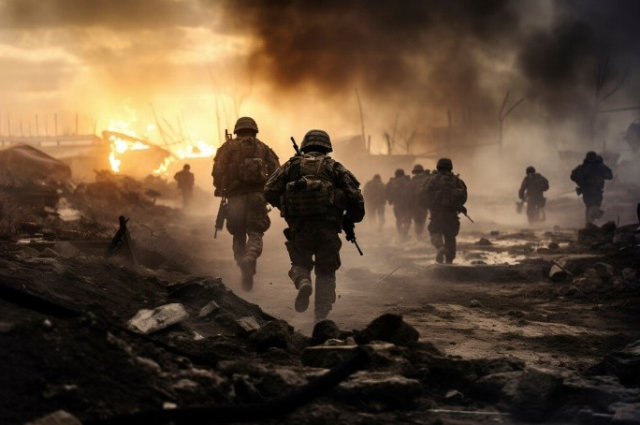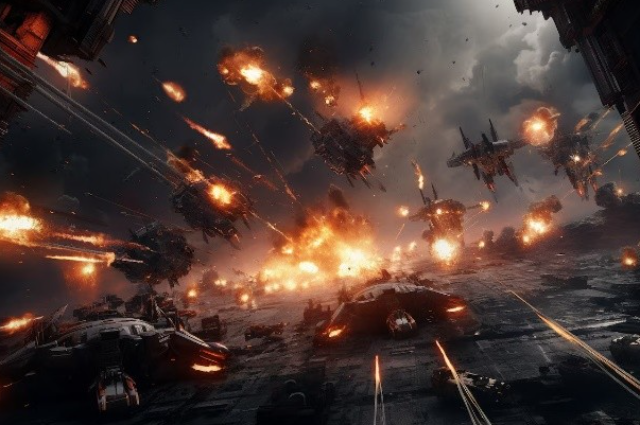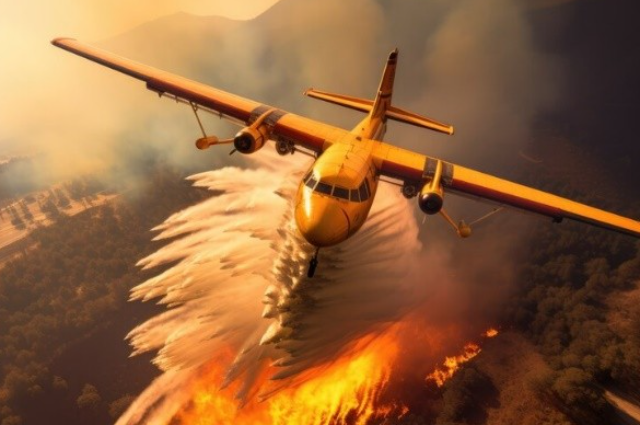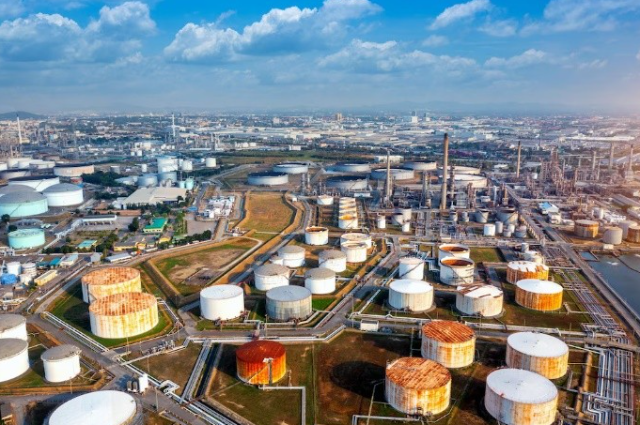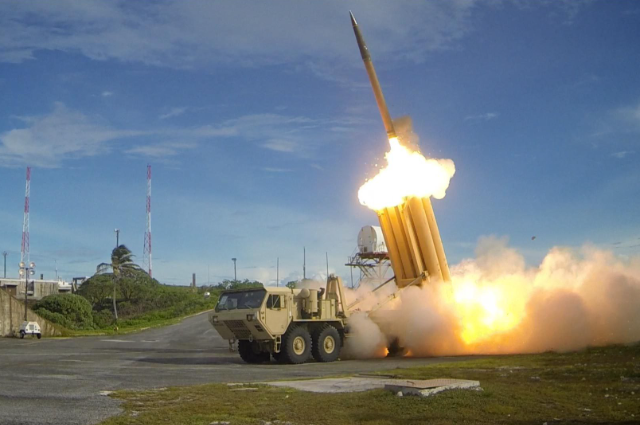The geopolitical landscape has shifted dramatically following Iran’s missile strike on Israel on October 1, 2024. This aggressive action was a direct reaction to the assassinations of prominent leaders from Hezbollah and Hamas—Hassan Nasrallah in Beirut and Ismail Haniyeh in Tehran, respectively. As the dust settles, analysts and political commentators are predicting that ‘will Israel be able to strike back aggressively?’
There are varying opinions on how Israel might respond to this provocative act. Some experts propose that Israel could target Iranian oil facilities that will affect Iran's economy. Others suggest that an attack on Iran’s nuclear infrastructure is a more expected scenario, given the ongoing concerns about Tehran’s nuclear ambitions.
The U.S. Stance: A Balancing Act
During this escalating situation, the Biden administration appears to be cautious about the potential for military escalation. While it has expressed opposition to both proposed retaliatory strikes—against oil and nuclear sites—it has taken proactive measures to strengthen Israel's defences. The U.S. has authorized the deployment of a Terminal High Altitude Area Defense (THAAD) missile defense system along with additional American troops to Israel. This move seems to be a strategic preparation for any possible Iranian counterattack following an Israeli operation.
Political Consequences: Trump’s Provocative Suggestions
Adding another layer to this complex situation, former President Donald Trump has publicly encouraged Israel to take decisive action against Iran’s nuclear capabilities. His remarks, urging Israel to “hit the nuclear reactors first,” reflect an aggressive stance that resonates with some groups within the Republican Party. Furthermore, Jared Kushner, Trump’s son-in-law and former senior advisor, has resonated similar sentiments by advocating for a robust response from Israel. As tensions continue to build up, the world watches closely, aware that each decision made by these key players could have significant repercussions for regional stability and international relations.
Israel’s Historical Attack and Its Consequences
While figures like Trump, Kushner, and other strong supporters of Israel may enthusiastically back an Israeli strike on Iran’s nuclear facilities, they likely have limited understanding of the repercussions as shown by the outcome of a similar Israeli attack on Iraq's nuclear program.
In 1981, Israel’s decision to destroy Iraq’s Osiraq nuclear reactor which was built with French assistance which led to unforeseen consequences. Instead of discontinuing Iraq's nuclear activities, it drove Saddam Hussein, Iraq's leader at the time to shift from a primarily peaceful nuclear program to a more aggressive pursuit of nuclear weapons. A strike on Iran's nuclear infrastructure could potentially trigger similar consequences.
Iraq’s Nuclear Journey
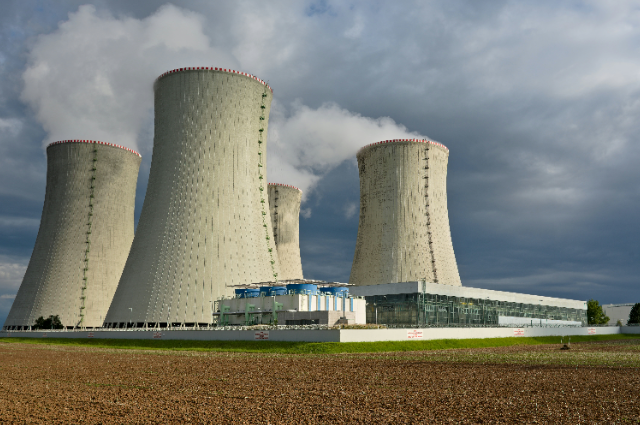
Photo by Lukáš Lehotský on Unsplash
Iraq’s nuclear program began in the 1960s with the help of the USSR, which provided a small research reactor and technical expertise. By the 1970s, Iraq had expanded its nuclear ambitions by purchasing a larger reactor from France known as Osiraq. This growth was supported by additional French and Italian expertise that was aiming to enhance Iraq’s civilian nuclear capacity. However, France had implemented technical safeguards to ensure the reactor couldn’t be repurposed for military objectives. They even shared these precautions with the United States, which was closely aligned with Israel.
At that time, Iraq was a signatory to the Nuclear Non-Proliferation Treaty (NPT) and its nuclear facilities were regularly inspected by the International Atomic Energy Agency (IAEA). Despite this, Israel falsely claimed Iraq was on the verge of developing a nuclear weapon which prompted their aggressive action.
Israel's “Pre-Emptive” Strike
Facing internal unrest and a possible loss in upcoming elections, the Israeli government had then decided to move forward with what they called a "pre-emptive" strike. On June 7, 1981, Israeli fighter jets that were manufactured in the U.S. conducted a mission to destroy the Osiraq reactor. The strike not only demolished the reactor but also resulted in the deaths of three Iraqi civilians and a French engineer. The strike sparked a wave of nationalist sentiment in Israel which helped Prime Minister Menachem Begin secure a narrow victory in the elections just a few weeks later.
The Unintended Fallout
In 2021, the release of declassified U.S. documents revealed that the Israeli attack didn’t succeed in restricting Iraq's nuclear ambitions. In fact, it had the opposite effect. Saddam Hussein became even more determined to develop a nuclear weapon and the strike attracted more Iraqi scientists to join the nuclear program.
As Jafar Dhia Jafar, an Iraqi nuclear scientist noted in his biography, the attack on Osiraq infuriated many, leading more professionals to contribute to Iraq’s nuclear efforts. Their goal was to break Israel’s dominance over nuclear weapons in the Middle East. These scientists proved to be even more valuable to Saddam than the reactor itself, which was destroyed in the attack.
Escalation of Conflict Between Hezbollah and Israel
October 8, 2023: Tensions Erupt at the Lebanon-Israel Border
On October 8, 2023, Hezbollah, a Lebanese armed group and Israel began exchanging fire across the Lebanon-Israel border. This exchange occurred just one day after a series of deadly Hamas-led attacks in southern Israel which left 1,139 people dead and over 200 people confined. In response to these attacks, Israel initiated a large-scale retaliation aimed at the Gaza Strip. This ongoing conflict in Gaza till October 2024 had claimed the lives of over 41,000 Palestinians, the majority of whom are women and children.
Hezbollah’s Response and the Strategic Shebaa Farms
On October 8, Hezbollah made a significant move by launching guided rockets and artillery at three Israeli military posts in the Shebaa Farms area. This border region which Lebanon claims has been under Israeli control since it was seized during the Six-Day War in 1967. Hezbollah’s actions were taken as a show of "solidarity" with the Palestinians in Gaza, marking a serious escalation of hostilities. The Israeli military quickly retaliated by firing artillery into the Lebanese area from where Hezbollah’s mortar fire had originated. This incident was just the beginning as cross-border exchanges of fire between Hezbollah and Israeli forces have continued almost daily since.
Hezbollah's Historical Role and Ongoing Conflict
Hezbollah, a militant group formed in 1982 to combat Israel's invasion and occupation of southern Lebanon has repeatedly stated that its attacks on Israel will persist until the Israeli offensive on Gaza finishes. Hezbollah's involvement in this broader conflict, though often seen as secondary to Hamas' actions in Gaza is part of a larger and more deep-rooted historical struggle between Lebanon and Israel.
Data on the Ongoing Conflict: October 7th, 2023
From October 7, 2023, until September 6, 2024, the Armed conflict locations and events data had reported a staggering 7,845 attacks exchanged between Israeli forces and Hezbollah with 82 percent of these initiated by Israel. Israeli attacks in Lebanon during this period resulted in the deaths of at least 646 people. On the other hand, Hezbollah and other militant groups carried out 1,768 attacks which resulted in the deaths of at least 32 Israelis. The situation between Israel and Hezbollah remains volatile with no clear resolution in view as both sides continue to engage in near-daily exchanges of fire. Hezbollah’s stance is firmly tied to the fate of Gaza by indicating that the conflict is likely to persist until a broader solution is found for the violence affecting both regions.
April 1, 2024: Destruction of the Iranian Embassy
On April 1, 2024, Israel conducted a missile strike on the Iranian embassy located in Damascus, Syria. This attack resulted in the destruction of the diplomatic facility and tragically claimed the lives of 13 individuals including Major General Mohammad Reza Zahedi, a prominent commander of Iran's Islamic Revolutionary Guard Corps (IRGC), along with his deputy.
Historically, Israel has focused its military efforts on Iranian military sites within Syria, but this strike represents a notable escalation as it directly targeted representative facilities. The implications of such an action are profound, as it blurs the lines between military and diplomatic engagements and raises questions about international norms regarding the credibility of diplomatic missions. In response to this aggressive act, Iran undertook to retaliate.
Iran's Retaliation with Missile Strikes
Just under two weeks later, on April 13, 2024, Iran responded with a significant military offensive by launching approximately 300 missiles and drones aimed at Israeli territory. This marked an essential moment in the conflict as it was the first instance of Iran directly firing missiles into Israel.
Despite this aggressive move, most of the missiles were intercepted before they could reach their targets. The Israeli military reported that they received support from allied nations, including the United States, the United Kingdom and France, which helped to neutralize many of these threats. Additionally, Jordan played a crucial role by intercepting some missiles that entered its airspace. The consequences of this aerial assault were severe for civilians in Israel; a seven-year-old girl suffered serious injuries due to missile fragments, while several others experienced minor injuries. The attack lasted for five hours and involved intense exchanges between Iranian forces and Israeli defences.
As tensions continue to rise between these two nations, the potential for further conflict appears to be large. The cycle of retaliation suggests that without intervention or dialogue, both countries may find themselves involved in a long-drawn-out and destructive confrontation that could have far-reaching consequences for regional stability and international relations.
July 31, 2024: Assassination of Ismail Haniyeh Sparks Escalation in Middle East Tensions
On July 31, 2024, a significant political figure in the Middle East, Ismail Haniyeh, was assassinated in Tehran, the capital of Iran. Haniyeh, who served as the political chief of Hamas, was killed during an airstrike that targeted the building where he was staying in the early hours of the day. This incident quickly led to accusations from both Hamas and Iranian officials, who pointed the finger at Israel as being responsible for the attack. The airstrike on Haniyeh came close after another Israeli operation that targeted a senior Hezbollah commander in Beirut indicating a possible coordinated strategy.
A Diplomatic Visit Interrupted
Haniyeh had travelled to Tehran to participate in the inauguration ceremony of Iran's President Masoud Pezeshkian the day before the attack. His presence in Iran was viewed as part of an ongoing relationship between Hamas and the Iranian leadership. The timing of his assassination, just after the ceremony has deepened the sense of urgency and concern in the region as it escalated already existing tensions between Israel, Hamas, and Iran.
Escalation of Hostilities
Hamas’s armed wing, known as the Qassam Brigades had quickly responded to Haniyeh’s death with a stern warning. They stated that the killing marked a dangerous escalation in their conflict with Israel by pushing the hostilities to "new levels." The group warned of dire repercussions, not just for Israel but for the entire region. Such a declaration suggests that the aftermath of Haniyeh's assassination could lead to intensified conflict by potentially involving more nations and groups aligned with Hamas or Israel.
Iran’s Reaction and Regional Implications
Iran’s Supreme Leader, Ayatollah Ali Khamenei, did not remain silent on the matter. He promised that Israel would face “harsh punishment” for its role in the assassination, further raising the stakes. The Supreme Leader’s statement reflects Iran's close ties with Hamas and its opposition to Israel. This promise of revenge adds another layer of complexity to an already unbalanced situation with the potential for further military actions and political fallout in the coming days or weeks.
A Region on Edge
The assassination of Ismail Haniyeh is not just a single event but a pivotal moment that could reshape the geopolitical landscape of the Middle East. With key players like Hamas, Hezbollah, Israel, and Iran involved, the risks of broader conflict are sharp. The incident emphasizes the nature of peace and stability in the region where one strike can lead to rapid escalation by dragging multiple nations into a dangerous curve of violence.
As the region braces for the "massive consequences" promised by the Qassam Brigades and awaits Iran’s response, it remains to be seen how this assassination will shape the future of the Israeli-Palestinian conflict and the broader Middle East.
September 23 and September 27, 2024: Israel’s Strikes on Lebanon
Between September 23 and September 27, 2024, Israel launched a devastating military campaign in Lebanon that resulted in the deaths of over 700 people. This event marked a significant escalation in the ongoing conflict between Israel and Hezbollah, a militant group based in Lebanon. The intensity of these airstrikes and the scale of destruction had raised concerns internationally, especially given the heavy toll on civilians.
September 23, 2024: Israel’s Airstrikes and their Targets
On September 23, 2024, Israel’s military announced it had carried out more than 650 airstrikes by targeting around 1,600 Hezbollah-related sites across Lebanon. These strikes stretched from the southern regions of Lebanon such as Bint Jbeil and Aitaroun, all the way to Baalbek in the Bekaa Valley, a key area in the country’s north. The geographic spread of these attacks shows the widespread nature of the operation by affecting many communities across the nation.
Civilian Casualties and the Death of Hassan Nasrallah
In a series of airstrikes carried out over five days, more than 700 Lebanese people lost their lives. The victims included civilians with 50 children and 94 women among those killed. The death toll highlights the tragic human cost of this conflict as residential areas were not spared from the bombardment.
One of the most significant casualties was Hassan Nasrallah, the leader of Hezbollah for 32 years. Israeli media reported that Nasrallah was killed during a major assault on a residential suburb of Beirut. The Israeli military claimed responsibility for the assassination which reportedly involved the use of "bunker buster" bombs. These bombs had been designed to penetrate fortified structures and are particularly destructive when used in populated areas. According to the Geneva Convention, the use of such bombs in residential zones is prohibited due to the high risk they pose to civilians.
The Wounded and the Displacement Crisis
Lebanon’s Ministry of Public Health reported that at least 1,835 people were wounded in the attacks. The injuries ranged from severe to minor which added stress to Lebanon's already weak healthcare system, particularly in hospitals and clinics.
In addition to the physical devastation, the conflict created a large-scale humanitarian crisis. The United Nations Office for the Coordination of Humanitarian Affairs (UNOCHA) estimated that at least one million people were displaced as a result of the strikes. A staggering 90 percent of these displacements occurred in the week that was leading up to October 1, forcing many people to flee their homes. With shelters demolished and basic services not delivered, many of the displaced were left to sleep in public spaces—streets, beaches, parks, or even in their cars.
Hezbollah’s Retaliation and Ongoing Conflict
On September 24, Hezbollah responded to the Israeli strikes by launching its own aerial attack. Using drones, Hezbollah targeted Israel’s Atlit naval base that was located south of Haifa. This marked a notable escalation in the conflict, as Hezbollah’s use of drones reflected its growing capabilities in modern warfare. Despite this retaliation, Israeli attacks continued, further deepening the humanitarian crisis in Lebanon. The scale of the displacement and the destruction of infrastructure indicated that the conflict was far from over with no clear resolution in sight.
The events between September 23 and 27, 2024, highlight the devastating consequences of prolonged conflict in the region. Israel’s airstrikes and Hezbollah’s retaliatory actions have not only resulted in significant loss of life but also displaced large numbers of civilians. As the situation continues to evolve, the international community remains concerned about the ongoing violence and its impact on the civilian population.
Lessons for Future Conflicts
The historical precedent of Israel's strike on Iraq suggests that aggressive military actions against nuclear programs can backfire. Rather than eliminating nuclear ambitions, they may strengthen the resolve of the targeted nation to pursue nuclear capabilities as seen with Iraq. A similar strike on Iran could have comparable and unintended outcomes.
Escalating Tensions in the Middle East
The recent military actions involving Israel and Iran have significantly intensified the potential for a large-scale conflict throughout the Middle East. Israel's intrusion into Lebanon, coupled with Iran's missile strikes against Israeli targets, comes at a time when hostilities are already intense in Gaza. This alarming situation has raised concerns about a broader regional conflict, despite ongoing diplomatic efforts to ease the escalating tensions. UN Secretary-General Antonio Guterres has highlighted the terrible situation, warning of a "sickening cycle of escalation after escalation."
The Question of Retaliation
Israeli Prime Minister Benjamin Netanyahu reacted promptly to the Iranian missile launch, which involved approximately 200 missiles aimed at Israel. He characterized the attack as a significant error on Iran's part, asserting that they would face consequences for their actions. David Khalfa, a Middle East analyst at the Jean-Jaures Foundation in Paris, emphasized that Israel has little option but to retaliate due to the scale of the attack and the shift in targets towards sensitive military installations.
There is speculation regarding whether Iran and Israel genuinely seek war. According to expert Citrinowicz, Iran appears to have prepared for potential Israeli responses and is ready to act decisively. Sima Shine, another expert on Iranian affairs noted that Iran possesses challenging military capabilities, including the ability to launch over 200 missiles and deploy drones. She also cautioned about possible "terrorist operations abroad," which could target Israeli diplomatic missions or Jewish community centres.
The critical factor at this stage is how Israel chooses to respond as this decision could determine whether the situation escalates into a full-blown regional war. Sina Toossi, a senior fellow at the Center for International Policy in Washington remarked that both Netanyahu and Iranian leaders are engaging in risky exercises with each escalation intensifying the stakes.
October 7, 2024: Military Engagements on Multiple Fronts
Despite their declarations against escalating violence both Iran and Israel find themselves deep-rooted in military conflicts. Israel is currently engaged in combat against Hamas in Gaza, focusing on rescuing hostages taken during the October 7 attacks. Simultaneously, Israeli forces are involved in ground battles against Hezbollah in Lebanon after conducting extensive air strikes against the group. Additionally, Israel faces threats from other armed factions across the region including Yemen's Houthi rebels who have increased their missile and drone attacks.
Seeking Political Solutions
Ultimately, experts like Citrinowicz believe that both Iran and Israel will strive for a political resolution to their conflicts. This approach may find support from external powers such as the United States and France, whose influence—especially in Lebanon—could be pivotal in restoring stability to the region. As tensions continue to rise, the international community watches closely for any signs of further escalation or potential paths for peace.
West Asia’s Escalating Conflict
Israel’s retaliatory strikes have pushed the region towards the brink of war, further fueled by targeted assassinations of key figures like Hamas leader Yahya Sinwar by Israeli forces.
Unpredictable Consequences and High Stakes
The killing of high-profile figures like Ismail Haniyeh in Tehran underscores the unpredictable nature of the conflict. Israel has a history of responding fiercely to any aggression, often with overwhelming force. However, in the case of Iran, things may unfold differently due to complex geopolitical factors. While Israel’s retaliation might be measured, it is unlikely to ignore provocations from Tehran. A direct confrontation with Iran, unlike with its proxies like Hamas and Hezbollah, could have severe and far-reaching global consequences. But Israel’s response, though inevitable remains difficult to predict in terms of timing and scale.
Historical Hostility and Modern Divides
Since its founding in 1948, Israel has faced constant aggression from neighbouring Muslim countries. Its history is marked by numerous wars, notably in 1948, 1967, 1973 and more recently in 2023. However, the landscape has shifted significantly over the decades. While the Arab nations once presented a unified front against Israel, today, they are more fragmented. The geopolitical changes over the last two decades have reshaped alliances and enmities.
Saudi Arabia and UAE: Changing Priorities
Countries like Saudi Arabia and the UAE have started to chart a different path, understanding that their future cannot solely depend on oil. With the growing threat of climate change and the inevitable depletion of fossil fuels, they recognize the need for economic diversification. These nations are now more focused on modernizing their economies rather than supporting old ideological battles. In contrast, Iran remains committed to its anti-Zionist stance, using proxies like Hezbollah, Hamas, and other paramilitaries to challenge Israel.
The Abraham Accords and Its Fallout
In 2020, the Abraham Accords offered a hopeful vision for peace and cooperation between Israel and several Arab nations, including the UAE and Bahrain. However, the Hamas attack on Israel on October 7, 2023, shattered any optimism for lasting peace. Iran’s use of its proxies to maintain pressure on Israel has continued, even as Israel retaliates. Now, with many of these proxies weakened by Israel’s military actions, Iran finds itself increasingly isolated, waiting for what may come next from the Israeli Defense Forces.
In this evolving and precarious situation, the region remains on edge with potential global complications hinging on the next moves in this long-standing conflict.
Overview of Iran's Position Against Israel and the US
Iran's geopolitical stance in the Middle East, particularly regarding its relationship with Israel and the United States is increasingly dangerous. The Iranian government faces significant internal disapproval which is compounded by international sanctions that limit its economic capabilities. Despite some external support from nations like Russia and China, this backing appears insufficient to transform Iran into a challenging opponent against Israel and its allies.
Iran's Internal Challenges
- Unpopularity of the Theocratic Government: The Iranian regime struggles with widespread domestic discontent, which undermines its ability to project power externally.
- Economic Strain from Sanctions: Ongoing sanctions have severely impacted Iran's economy, limiting its military and diplomatic options.
Limited External Support
- Russian and Chinese Assistance: While both countries provide some level of support, it is not robust enough to enable Iran to challenge Israel effectively.
- Regional Diplomacy: Iran is attempting to rally support from other Islamic nations, including the UAE and Saudi Arabia, but these countries are cautious about escalating tensions.
Regional Dynamics and Potential Conflicts
The current geopolitical landscape is marked by heightened tensions between Iran, Israel, and their respective allies. Both sides have engaged in military actions that threaten to escalate into broader conflict.
Iran's Military Capabilities
- Proxy Forces: Iran has utilized proxy groups like the Houthis to exert influence in the region. These groups are capable of disrupting oil supply routes, which could have global economic repercussions.
- Direct Military Engagement: Recent military exchanges between Israel and Iran indicate a shift in how both nations engage with one another, potentially leading to direct confrontations.
Impact on Global Oil Supply Chains
The ongoing conflicts in the Middle East pose significant risks to global oil supply chains, particularly through critical chokepoints like the Strait of Hormuz.
- Strait of Hormuz: This narrow passage is vital for oil exports from major producers. Any disruption here could lead to significant increases in global oil prices due to supply shortages.
- Houthi Threats: The Houthis have a history of targeting shipping routes in the Red Sea, which could worsen supply chain issues if tensions escalate further.
Emerging Alternatives for Energy Supply
In light of potential disruptions, countries like India are exploring alternative sources of crude oil to mitigate risks associated with Middle Eastern conflicts.
Venezuelan Oil Imports
- India's Strategy: In 2024, India imported approximately 22 million barrels of Venezuelan oil, representing about 1.5% of its total purchases. Venezuelan crude offers a cost advantage compared to other sources.
- Economic Implications: The availability of cheaper Venezuelan oil could help stabilize India's energy needs with rising global prices due to geopolitical tensions.
Iran's ability to effectively confront Israel and the US is hampered by internal disapproval and economic sanctions. While it seeks support from regional allies, those nations are hesitant to escalate tensions further. The potential for conflict remains high, especially concerning oil supply chains that are critical for global markets. As countries like India look towards alternatives such as Venezuelan oil, the dynamics of energy supply will continue to evolve in these geopolitical challenges.
The U.S. Deployment of THAAD: A New Chapter in Middle Eastern Tensions
Recently, the United States announced the deployment of the Terminal High Altitude Area Defense (THAAD) system, which will be managed by around 100 troops. This transportable defense system is designed to intercept missiles of various ranges during their final phase of flight. The decision to deploy THAAD appears to be linked to Israel's response to recent missile, rocket, and drone attacks from Iran, which occurred nearly a month ago. This move indicates a growing U.S. involvement in what has become a significant conflict between Israel and Iran, raising the likelihood of direct American action against Iran. However, it’s important to note that Iran is likely hesitant to escalate tensions further, especially given its limited ability to counter advanced weaponry.
Iran's Strategy: Asymmetrical Warfare
Iran's approach to conflict often relies on small, highly armed groups capable of inflicting damage disproportionate to their size. This strategy is represented by tactics such as suicide bombings and the use of improvised explosive devices (IEDs). These methods are often labelled as "weapons of the weak" in their struggle against stronger opponents. On the other hand, when violence is delivered through conventional military means—resulting in civilian casualties—the term "collateral damage" is often used to describe the situation by reflecting a troubling double standard in how violence is categorized.
Humanitarian Crisis in Gaza and Beyond
Israel's actions in Gaza, the West Bank, and Lebanon have raised serious concerns regarding violations of humanitarian laws. The international community, particularly the United Nations, has struggled to address the escalating violence and its impact on civilians. Many people in Gaza have been displaced multiple times, forced to flee their homes while facing chronic starvation and a lack of medical assistance due to Israeli barriers on support groups.
The Cycle of Violence: Seeds of Future Terrorism
The ongoing cycle of violence raises concerns about its long-term implications for future generations. The memories of destruction and suffering inflicted by Israel could foster hatred among Palestinians and other ethnic groups. As images of devastation circulate globally through social media and news outlets, there is a real possibility that this could lead to a rebirth of terrorism. The emotional landscape of this conflict may increasingly draw lines along religious identities—particularly between Islam, Christianity, and Judaism—especially given the perceived support from Western nations like the U.S. for Israel’s military actions.
The Need for Organization and Support
While conditions may be suitable for the emergence of terrorism, they still require organizational structure and some level of state backing to pose a significant threat. Without a shift in how Iran is approached diplomatically or militarily, the conflict is likely to persist with its current anti-Israeli sentiment. Countries like Afghanistan under Taliban rule could also play a role in this dynamic. Additionally, it wouldn’t be surprising if nations like China and Russia provide covert support for anti-U.S. efforts in the region as it aligns with their geopolitical interests.
Potential Leaders of Future Conflicts
In terms of leadership within these movements, new figures similar to Osama bin Laden could arise, particularly if perceptions frame this conflict as a religious war. Such narratives could ignite strong emotions across the Arab world and beyond—potentially drawing countries like Afghanistan, Pakistan, Maldives, Bangladesh, and Indonesia into future conflicts. Religious divisions also exist within many African and Central Asian nations that could become involved. Regions like Xinjiang in China, home to a large population facing religious suppression might also see unrest if China’s attention wavers due to geopolitical pressures.
India’s Position: Caught in Global Religious Wars?
India could find itself entangled in these rising global religious conflicts as well. The emotional narratives fuelled by brutality showcased on social media could influence public sentiment significantly. Historically, during the rise of bin Laden-led jihadism, India managed to remain largely uninvolved despite having a substantial Muslim population; any impact it faced was primarily due to terrorist groups operating from Afghanistan and Pakistan. The next generation of fighters may be more technologically adept than previous ones. This technological proficiency could enable small groups to exploit cyberspace as a means of inflicting damage on larger opponents. Cyber warfare presents opportunities for causing significant disruption at relatively low costs, particularly targeting economic infrastructures and transportation networks. As tensions escalate in the Middle East and beyond, understanding these dynamics becomes crucial for anticipating future conflicts and their potential global repercussions.
. . .
References:


